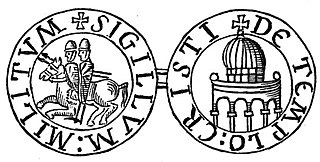Related Research Articles

According to Christian tradition, the True Cross is the cross on which Jesus of Nazareth was crucified.
Fulcher of Chartres was a priest who participated in the First Crusade. He served Baldwin I of Jerusalem for many years and wrote a Latin chronicle of the Crusade.
Alberic of Ostia (1080–1148) was a Benedictine monk, diplomat and Cardinal Bishop of Ostia from 1138 to 1148. He was one of the most important people in the administration of Pope Eugenius III, especially due to his diplomatic skills.
Fulkof Angoulême was the Latin patriarch of Jerusalem from 1146 to his death in 1157.
William of Malines was a Flemish priest who was the prior of the Church of the Holy Sepulchre from 1127 to 1130 and was then Latin patriarch of Jerusalem from 1130 until his death. He is sometimes called William I to distinguish him from William of Agen, second patriarch of that name, but he was the second William to serve as prior of the Holy Sepulchre after William the Englishman.

Amalric of Nesle was a Catholic prelate who served as the Latin patriarch of Jerusalem from late 1157 or early 1158 until his death. Amalric focused chiefly on managing church property; he showed very little political initiative and, unlike many contemporary bishops in the crusader states, had no interest in military affairs.

The Templum Domini was the name attributed by the Crusaders to the Dome of the Rock in Jerusalem. It became an important symbol of Jerusalem, depicted on coins minted under the Catholic Christian Kingdom of Jerusalem.
Ralph of Domfront was the archbishop of Mamistra and second Latin patriarch of Antioch from 1135 until 1140. William of Tyre describes him as "a military man, very magnificent and generous, a great favourite of the common people and with those of knightly birth."

The timeline of the Kingdom of Jerusalem presents important events in the history of the Kingdom of Jerusalem—a Crusader state in modern-day Israel and Jordan—in chronological order. The kingdom was established after the First Crusade in 1099. Its first ruler Godfrey of Bouillon did not take the title of king and swore fealty to the Latin Patriarch of Jerusalem, Daimbert. Godfrey's brother and successor Baldwin I was crowned the first king of Jerusalem without doing homage to the patriarch in 1100. By 1153, Baldwin I and his successors captured all towns on the Palestinian coast with the support of Pisan, Genoese and Venetian fleets and also took control of the caravan routes between Egypt and Syria. The kings regularly administered other crusader states—the Counties of Edessa and Tripoli and the Principality of Antioch—on behalf of their absent or underage rulers.
Robert of Nantes was the Latin patriarch of Jerusalem from 1240 to 1254.
William I was the second Latin archbishop of Tyre from 1128 until 1134 or 1135. He was originally from England and served as prior of the Church of the Holy Sepulchre before his appointment as archbishop.
Latin Diocese of Tortosa in Syria was a Roman Catholic diocese established in the Syrian city of Tartus after the First Crusade. It had a resident bishop between 1128 and 1291. The cathedral of Tortosa became the site of a Marian shrine.
Gerold of Lausanne, was abbot of Molesme, abbot of Cluny, bishop of Valence, and Latin patriarch of Jerusalem in the 13th century.
The Abbey of Saint Lazarus was a Benedictine convent in Bethany in the Kingdom of Jerusalem. It was founded in 1138 by Queen Melisende and King Fulk at the reputed site of the tomb of Lazarus. The queen installed her sister Ioveta in the convent and lavishly endowed the abbey, making it richer than any other religious community in the kingdom. It lost much of its estates, including Bethany itself, during the Muslim reconquests of the Latin East, and retreated to the Kingdom of Cyprus, where it faded into obscurity in the 14th century. Parts of the abbey buildings are still visible in Bethany.
Stephanie of Courtenay was a Latin noblewoman from the crusader states who served as the abbess of Great Saint Mary's in Jerusalem. She belonged to the House of Courtenay which ruled the County of Edessa and worked to further her abbey's wealth and standing. She is best known as a source of information for William of Tyre's chronicle of the crusader states.
Peter of Barcelona was a prelate of the Catholic Church in the Kingdom of Jerusalem. He was prior of the Holy Sepulchre from 1144 to 1151 and then archbishop of Tyre until his death.
William was the bishop of Acre in the Kingdom of Jerusalem from c. 1164 until his death on 29 June 1172. He was sent on several diplomatic missions by King Amalric. He was murdered by an apparently mentally ill retainer while returning from a mission to his native Italy.
John was the bishop of Banias in the Kingdom of Jerusalem from 1161 until his death in 1170.
The diocese of Banias was an episcopal see centered on Banias in the region of Syria. It was originally an Eastern Orthodox see. In 1140 Banias was captured by King Fulk of Jerusalem. The same year Adam of Acre became the first Roman Catholic bishop to be installed in Banias. Archaeologist Denys Pringle assumes that a cathedral church was constructed in Banias, but its location has not yet been determined.
Aschetinus or Anschetin was the first Roman Catholic bishop of Bethlehem in the Kingdom of Jerusalem from 1108 until his death.
References
- 1 2 Hamilton 1980, p. 397.
- 1 2 Hamilton 1980, p. 84.
- ↑ Hamilton 1980, p. 116.
- 1 2 Hamilton & Jotischky 2020, p. 86.
- ↑ Hamilton 1980, p. 120.
- ↑ Hamilton 1980, p. 106.